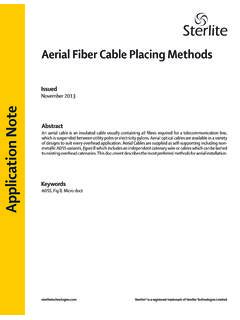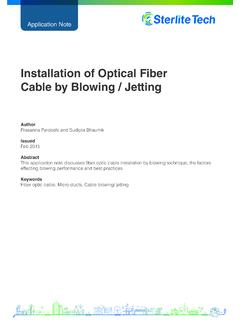Transcription of Underground Installation of Optic Fiber Cable Placing
1 Application Notes Underground Installation of Optic Fiber Cable Placing Issued November 2013. Abstract Underground placement is necessary and unavoidable in certain areas for various reasons such as nature and heritage conservation, natural obstacles, aesthetics, space and safety. Placing cables Underground has the added benefits of reducing transmission losses, aiding planning consent and reduced risk of service supply loss through extreme weather. This practice covers the basic guidelines for Installation of Fiber - Optic Cable in Underground Cable . Keywords Manholes, winches, Sheaves, Jetting Method Contents 2. Introduction 2. 3. General 3. 4. Precautions 3. Cable Handling 3. LED and Laser Precaution 3. Optical Fiber Handling Precautions 4.
2 Material Safety 4. Safety During Installation 5. Personal Protective Equipment 5. Traffic Safety 5. Placing Equipment 5. Cable Protection and Handling 6. 5. Preparation for Cable Placing 6. Pre-Construction Survey 6. Cable Staging Area 9. 6. Tools and Materials 10. Innerduct and Micro-Ducts 13. Lubricant 14. Sheaves, Quadrant Block, and Manhole Frame 15. Winches 15. Cable Blowing and Pushing Engine 15. 7. Cable Placing Methods 15. Normal Cable Pulling Method 16. Bidirectional Figure-Eight Procedure 19. Placing Assistance 20. Back-Feeding Assist to Cable Pulling 21. 8. Manhole Housekeeping 21. Cable Coiling 21. Racking Cable and Innerduct 22. 9. Addition Information 22. Introduction Underground Cable is placed into ducts which are being built below the ground surface.
3 In urban areas where space for telecommunications Cable is limited, it needs to be used more efficiently. In Underground Installation , the conduit provides protection from both physical and environmental abuse. The conduit protects Cable from shifting rocks, aggressive rodents, and/. or damage from hand shovels. Underground Cable that is in conduit is easy to replace or upgrade. The old Cable can be pulled out of the conduit and the new pulled in without extensive and expensive digging. Underground Cable and ducts are part of the Underground conduit system. Telecommunication conduits are made from various materials and buried directly into the soil or encased in concrete. Fiber Optic cables have provided a more optimal use of available Underground conduit space because of its small Cable diameter and the much higher communications traffic capacity of each Cable .
4 Optical Cable is usually placed in a 25 to 40 mm inside diameter (ID) sub-duct which is placed into an existing larger diameter communications conduit. Most communications conduits can be fitted with three or four sub-ducts. Sub-ducts are often referred to as innerducts. An innerduct provides a more efficient use of the conduit system space, with a clean low coefficient-of-friction pathway and an extra measure of mechanical protection for an optical Cable . If micro-duct cables are used, they are usually placed into small diameter ducts that are placed inside of the innerducts, nested two levels within a communications conduit system. These small diameter ducts are usually from approx 5 mm to 14 mm inside diameter and called micro- ducts.
5 Micro-duct Cable is blown (jetted) into the micro-duct. Normally, standard size Fiber Optic cables are pulled into innerduct (sub-ducts). Underground Cable Urban New Old Campuses Rural Suburban Suburban Innerduct Micro-Ducts = Used often in this application = Can be used in the application under certain circumstances Table 1 Commonly Used Cable Types for Various OSP Applications 1. Micro-ducts can also be placed directly into larger telecommunications conduits or can be factory assembled into a composite unit of multiple micro-ducts. 3. General The Underground Placing methods described in this document are intended as guidelines. National, state, local, and corporate specifications, regulations, and industry recommendations normally take precedence over these.
6 It is impossible to cover all the conditions that may arise during a Placing operation. Individual company practices for Placing Fiber Optic Cable should supersede any conflicting instructions in this document whenever they do not exceed the Cable 's optical and mechanical performance specifications. The methods used to place Fiber Optic cables in ducts are similar to those used to place copper Cable . Optical Cable is a high capacity transport medium that is sensitive to excessive pulling force, tight bends, and crushing forces, therefore, proper care must be taken during the Installation procedure. Fiber Optic cables are ordered in specific lengths as calculated by an OSP (Outside Plant). Engineer. Their lengths are determined by measuring the distance between splice manholes plus the excess Cable length required for racking the Cable at all manhole locations and slack storage for maintenance.
7 Additional Cable length is required at each splice manhole to reach to the actual splice location (often in a trailer or tent adjacent to the manhole). In addition, extra length should be included in the ordered length to be available if errors are made during the splicing operation. If the excess splice length is not known, the splicing foreman should be consulted. Never cut a Fiber Cable without first consulting the OSP Engineer responsible for the job. 4. Precautions Cable Handling All optical Fiber cables are sensitive to damage during shipping, handling, and Installation . Some of the important parameters that need special attention during Cable Installation are: Cable bending radius: Optical Fiber cables are designed with a minimum bending radius and maximum tensile strength.
8 The Cable should never be bent below its minimum bending radius. Doing so can result in bending losses and/or breaks in the Cable 's fibers. Generally the minimum bending radius of a Fiber Cable under load is 20 D, where D is the diameter of Cable ; the minimum bending radius of a Fiber Cable under no load is 15 D. Cable Placing Tension: Optical Fiber cables are designed with a maximum tensile strength. The Cable should never be loaded beyond its maximum tensile strength. Exceeding the Cable 's Placing tension provided by Sterlite in the Cable Data Sheet/Specification, can alter Cable and Fiber performance and shorten its service lifetime. LED and Laser Precaution LED and Laser beams used in Fiber Optic testing and transmission systems are invisible to the human eye and can seriously damage the eye.
9 Viewing these beams directly may not cause any pain and the iris of the eye does not close automatically as it does while viewing a bright light. As a result the eye may not react to protect itself causing serious damage to result to the retina. Therefore, Never look directly into a Fiber end that has a laser or LED coupled to it. Never look directly into a Fiber end using any magnifying lense. If an eye is accidentally exposed to an LED or laser beam, immediately seek medical attention. Optical Fiber Handling Precautions Broken Fiber ends created during termination and splicing can be dangerous. These ends are extremely sharp and can easily penetrate the skin. They invariably break off and are very hard to find and remove.
10 Often tweezers and a magnifying glass are needed to remove them from the skin. Any delay in their removal could lead to an infection, which is dangerous. Hence, Be careful while handling the fibers. Dispose of all scraps safely and properly. Do not eat or drink near the Installation area. Material Safety Fiber Optic splicing and termination processes often use various chemical cleaners and adhesives. The safety instructions developed for these substances should be followed. If there is confusion in the usage of these products, ask their manufacturer for a Material Safety Data Sheet (MSDS). Remember the following instructions while working with these chemicals. Always work in well-ventilated areas. Avoid skin contact with these cleaning materials as much as possible.





